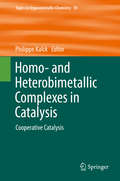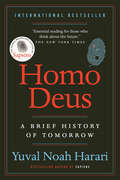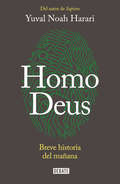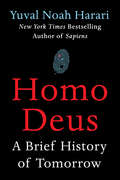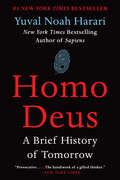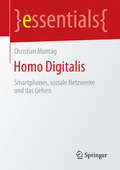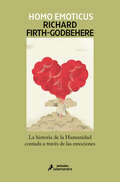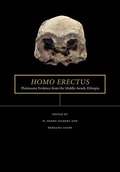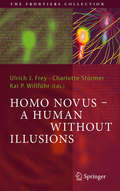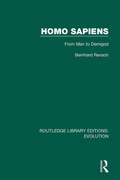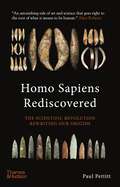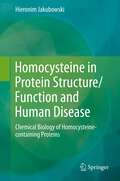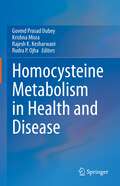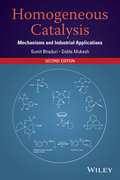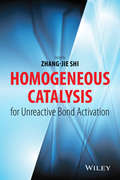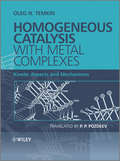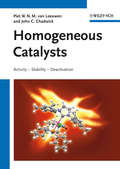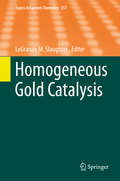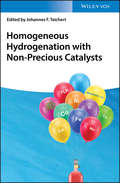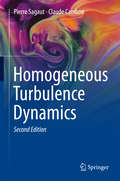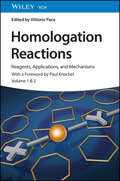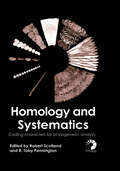- Table View
- List View
Homo- and Heterobimetallic Complexes in Catalysis
by Philippe KalckThe series Topics in Organometallic Chemistry presents critical overviews of research results in organometallic chemistry. As our understanding of organometallic structure, properties and mechanisms increases, new ways are opened for the design of organometallic compounds and reactions tailored to the needs of such diverse areas as organic synthesis, medical research, biology and materials science. Thus the scope of coverage includes a broad range of topics of pure and applied organometallic chemistry, where new breakthroughs are being achieved that are of significance to a larger scientific audience. The individual volumes of Topics in Organometallic Chemistry are thematic. Review articles are generally invited by the volume editors. All chapters from Topics in Organometallic Chemistry are published OnlineFirst with an individual DOI. In references, Topics in Organometallic Chemistry is abbreviated as Top Organomet Chem and cited as a journal
Homo Deus: A Brief History of Tomorrow
by Yuval Noah HarariFrom the author of the international bestseller Sapiens: A Brief History of Humankind comes an extraordinary new book that explores the future of the human species. Yuval Noah Harari, author of the bestselling Sapiens: A Brief History of Humankind, envisions a not-too-distant world in which we face a new set of challenges. In Homo Deus, he examines our future with his trademark blend of science, history, philosophy and every discipline in between. Homo Deus explores the projects, dreams and nightmares that will shape the twenty-first century - from overcoming death to creating artificial life. It asks the fundamental questions: Where do we go from here? And how will we protect this fragile world from our own destructive powers? This is the next stage of evolution. This is Homo Deus. War is obsolete You are more likely to commit suicide than be killed in conflict Famine is disappearing You are at more risk of obesity than starvation Death is just a technical problem Equality is out - but immortality is in What does our future hold?From the Hardcover edition.
Homo Deus: A Brief History of Tomorrow
by Yuval Noah HarariInternational Bestseller From the author of the international bestseller Sapiens: A Brief History of Humankind comes an extraordinary new book that explores the future of the human species. Yuval Noah Harari, author of the bestselling Sapiens: A Brief History of Humankind, envisions a not-too-distant world in which we face a new set of challenges. In Homo Deus, he examines our future with his trademark blend of science, history, philosophy and every discipline in between. Homo Deus explores the projects, dreams and nightmares that will shape the twenty-first century – from overcoming death to creating artificial life. It asks the fundamental questions: Where do we go from here? And how will we protect this fragile world from our own destructive powers? This is the next stage of evolution. This is Homo Deus. War is obsolete You are more likely to commit suicide than be killed in conflict Famine is disappearing You are at more risk of obesity than starvation Death is just a technical problem Equality is out – but immortality is in What does our future hold?
Homo Deus: Breve historia del mañana
by Yuval Noah HarariTras el éxito de Sapiens. De animales a dioses, Yuval Noah Harari vuelve su mirada al futuro para ver hacia dónde nos dirigimos. La guerra es algo obsoleto. Es más probable quitarse la vida que morir en un conflicto bélico. La hambruna está desapareciendo. Es más habitual sufrir obesidad que pasar hambre. La muerte es solo un problema técnico. Adiós igualdad. Hola inmortalidad. ¿Qué nos depara el futuro? Yuval Noah Harari, autor bestseller de Sapiens. De animales a dioses, augura un mundo no tan lejano en el cual nos veremos enfrentados a una nueva serie de retos. Homo Deus explora los proyectos, los sueños y las pesadillas que irán moldeando el siglo XXI -desde superar la muerte hasta la creación de la inteligencia artificial. - Cuando tu Smartphone te conozca mejor de lo que te conoces a ti mismo, ¿seguirás escogiendo tu trabajo, a tu pareja y a tu presidente? - Cuando la inteligencia artificial nos desmarque del mercado laboral, ¿encontrarán los millones de desempleados algún tipo de significado en las drogas o los juegos virtuales? - Cuando los cuerpos y cerebros sean productos de diseño, ¿cederá la selección natural el paso al diseño inteligente? Esto es el futuro de la evolución. Esto es Homo Deus.
Homo Deus: Breve historia del mañana
by Yuval Noah HarariTras el éxito de Sapiens, Yuval Noah Harari vuelve su mirada al futuro para ver hacia dónde nos dirigimos. Bestseller del New York Times con 1 millón de ejemplares vendidos Yuval Noah Harari, autor de Sapiens, un fenómeno internacional unánimemente aclamado por la crítica, regresa con una secuela igualmente original, convincente y provocadora, centrando su atención en el futuro de la humanidad y en nuestra obsesión por convertirnos en dioses. A lo largo del último siglo, la humanidad ha logrado lo imposible frenando la hambruna, la peste y la guerra. Por primera vez en la historia, más personas mueren por obesidad que por pasar hambre y hay más probabilidades de quitarse la vida que de morir en un conflicto bélico o un atentado terrorista. ¿Qué pasará con la democracia cuando Google y Facebook lleguen a conocer nuestros gustos y preferencias políticas mejor que nos conocemos a nosotros mismos? ¿Qué pasará con el estado de bienestar cuando la inteligencia artificial expulse a los individuos del mercado laboral, creando una «clase innecesaria» de humanos? ¿Cómo podremos lidiar con los avances en ingeniería genética? ¿Terminará Silicon Valley por establecer nuevas religiones en lugar de enfocarse a producir únicamente dispositivos inteligentes? Homo Deus explora los proyectos, los sueños y las pesadillas que configurarán el siglo XXI: desde superar la muerte hasta la creación de la inteligencia y la vida artificial. ¿Hacia dónde nos dirigimos? ¿Cómo protegeremos al mundo de nuestros propios poderes destructivos? He aquí una mirada hacia el futuro de la evolución. He aquí Homo Deus. Reseñas:«Yuval Noah Harari, autor del fenómeno Sapiens, reflexiona sobre el futuro de la humanidad en Homo Deus, un libro de prosa inteligente, fresca y libre de prejuicios.»Jorge Wagensberg, Babelia «Aún más legible, incluso más importante que su excelente Sapiens.»Kazuo Ishiguro, Premio Nobel de Literatura «Homo Deus te impactará y te cautivará, pero sobre todo te hará pensar como nunca antes.»Daniel Kahneman, Premio Nobel de Economía «Harari se convierte en una especie de filósofo del futuro que desarrolla las intuiciones de su primera obra [...] un ritmo y una energía que convierten Homo Deus en un libro francamente ameno.»El Cultural «El épico y mundialmente celebrado Sapiens recibe la secuela que necesitaba: una intensa y compulsiva investigación sobre el apocalipsis de la humanidad en un futuro impulsado por la tecnología.»The Guardian «Un libro implacable y fascinante que seguramente se convertirá, y merece ser un éxito de ventas.»Kirkus Review «Un estimulante libro que lleva al lector a profundizar sobre cuestiones de identidad, conciencia e inteligencia.»The Observer «Un brebaje embriagador de ciencia, filosofía y futurismo.»Mail on Sunday «Un estudio brillante, original, estimulante e importante sobre hacia dónde se dirige la humanidad.»Evening Standard
Homo Deus: A Brief History of Tomorrow
by Yuval HarariOfficial U.S. edition with full color illustrations throughout.NEW YORK TIMES BESTSELLER Yuval Noah Harari, author of the critically-acclaimed New York Times bestseller and international phenomenon Sapiens, returns with an equally original, compelling, and provocative book, turning his focus toward humanity’s future, and our quest to upgrade humans into gods.Over the past century humankind has managed to do the impossible and rein in famine, plague, and war. This may seem hard to accept, but, as Harari explains in his trademark style—thorough, yet riveting—famine, plague and war have been transformed from incomprehensible and uncontrollable forces of nature into manageable challenges. For the first time ever, more people die from eating too much than from eating too little; more people die from old age than from infectious diseases; and more people commit suicide than are killed by soldiers, terrorists and criminals put together. The average American is a thousand times more likely to die from binging at McDonalds than from being blown up by Al Qaeda.What then will replace famine, plague, and war at the top of the human agenda? As the self-made gods of planet earth, what destinies will we set ourselves, and which quests will we undertake? Homo Deus explores the projects, dreams and nightmares that will shape the twenty-first century—from overcoming death to creating artificial life. It asks the fundamental questions: Where do we go from here? And how will we protect this fragile world from our own destructive powers? This is the next stage of evolution. This is Homo Deus.With the same insight and clarity that made Sapiens an international hit and a New York Times bestseller, Harari maps out our future.
Homo Deus: A Brief History of Tomorrow
by Yuval Noah HarariYuval Noah Harari, author of the critically-acclaimed New York Times bestseller and international phenomenon Sapiens, returns with an equally original, compelling, and provocative book, turning his focus toward humanity’s future, and our quest to upgrade humans into gods.Over the past century humankind has managed to do the impossible and rein in famine, plague, and war. This may seem hard to accept, but, as Harari explains in his trademark style—thorough, yet riveting—famine, plague and war have been transformed from incomprehensible and uncontrollable forces of nature into manageable challenges. For the first time ever, more people die from eating too much than from eating too little; more people die from old age than from infectious diseases; and more people commit suicide than are killed by soldiers, terrorists and criminals put together. The average American is a thousand times more likely to die from binging at McDonalds than from being blown up by Al Qaeda.What then will replace famine, plague, and war at the top of the human agenda? As the self-made gods of planet earth, what destinies will we set ourselves, and which quests will we undertake? Homo Deus explores the projects, dreams and nightmares that will shape the twenty-first century—from overcoming death to creating artificial life. It asks the fundamental questions: Where do we go from here? And how will we protect this fragile world from our own destructive powers? This is the next stage of evolution. This is Homo Deus.With the same insight and clarity that made Sapiens an international hit and a New York Times bestseller, Harari maps out our future.
Homo Digitalis: Smartphones, soziale Netzwerke und das Gehirn (essentials)
by Christian MontagDas vorliegende essential besch#65533;ftigt sich mit der Nutzung des Smartphones und gibt Antworten darauf, warum wir immer mehr Zeit mit diesen Ger#65533;ten verbringen. Es wird beschrieben, welche Gruppen besonders von einer #65533;berm#65533;#65533;igen Smartphone-Nutzung betroffen sind. Zus#65533;tzlich wird der Frage nachgegangen, ob digitale Welten tats#65533;chlich unser Gehirn ver#65533;ndern. Au#65533;erdem: Wie sieht eine gesunde Smartphone-Nutzung in der Familie und am Arbeitsplatz aus? Das Buch h#65533;lt Tipps f#65533;r einen m#65533;glichst stressfreien Umgang mit digitalen Welten bereit, damit wir wieder lernen, im Hier und Jetzt zu leben.
Homo emoticus: La historia de la Humanidad contada a través de las emociones
by Richard Firth-GodbehereLa historia humana contada desde las emociones. A los humanos nos gusta pensar en nosotros mismos como criaturas racionales. Sin embargo, algunos de los momentos más excepcionales de la historia no tratan de acontecimientos sino de sentimientos: los orígenes de la filosofía, el nacimiento del cristianismo, la caída de Roma, la Revolución científica o los grandes conflictos bélicos del siglo XX no pueden entenderse sin las emociones. Gracias a sus sólidos conocimientos en psicología, neurociencia, arte, filosofía y religión, Richard Firth-Godbehere hilvana un fascinante recorrido por la historia de la humanidad desde una perspectiva absolutamente original, un relato que explica cómo las emociones han modelado el mundo en el que vivimos con toda su complejidad, maravilla y diversidad. La crítica ha dicho...«Una mirada fascinante al papel de las emociones humanas en la forja de la historia y la cultura universales.»Gina Rippon, autora de El género y nuestros cerebros «Las emociones son una parte mucho más importante de la experiencia del ser humano de lo que la mayoría de la gente cree. Si quieres saber más sobre las emociones y cómo hemos llegado a entenderlas, este libro es exactamente lo que necesitas.»Dean Burnett, autor de El cerebro feliz «Tanto si buscas nuevas ideas, como historia narrativa, teoría psicológica o antropología cultural, este libro te enseñará algo nuevo sobre cómo la gente ha sentido a través de los tiempos. Un libro como ningún otro.»Thomas Dixon, autor de Weeping Britannia: Portrait of a Nation in Tears
Homo Erectus: Pleistocene Evidence from the Middle Awash, Ethiopia
by W. Henry Gilbert Berhane AsfawThis book provides the first detailed descriptions, photographs, and analysis of the fossil vertebrates--from elephants and hyenas to humans--from the Daka Member of the Bouri Formation of the Afar, a place renowned for an abundant and lengthy record of human ancestors.
Homo Novus - A Human Without Illusions
by Ulrich J. Frey Kai P. Willführ Charlotte StörmerConverging evidence from disciplines including sociobiology, evolutionary psychology and human biology forces us to adopt a new idea of what it means to be a human. As cherished concepts such as free will, naïve realism, humans as creation's crowning glory fall and our moral roots in ape group dynamics become clearer, we have to take leave of many concepts that have been central to defining our humanness. What emerges is a new human, the homo novus, a human being without illusions. Leading authors from many different fields explore these issues by addressing a range of illusions and providing evidence for the need, despite considerable reluctance, to relinquish some of our most cherished ideas about ourselves.
Homo Sapiens: From Man to Demigod (Routledge Library Editions: Evolution #9)
by Bernhard RenschOriginally published in 1972, Homo Sapiens examines how humans emerged from among the millions of other species and achieved our unique position within the animal kingdom. The book examines what direction future evolution will take and what may be regarded as the ‘meaning’ of human existence. It stipulates that these are the questions for which no real basis of discussion existed before the 20th century, and at the time of publication, some were still without a definite answer. The book sets out analyse these questions and the continuing debate that has arisen from their study. This is an account of the uniqueness of man in the animal kingdom, how this uniqueness arose during evolution, and what traces of it can be detected in animals other than man. The book describes the mental and physical evolution of man, from his earliest ancestors to the present day. He also gives an account of man’s cultural development seeking to establish that there is an underlying principal of cultural evolution, a principle that has been denied by many historians. Later chapters deal with the future and with possible forecasts of mankind’s further physical, intellectual and cultural evolution.
Homo Sapiens Rediscovered: The Scientific Revolution Rewriting Our Origins (The Rediscovered Series)
by Paul PettittA world renowned expert reveals how our understanding of the evolution of our species has been transformed by momentous discoveries and technological advancements. Who are we? How do scientists define Homo sapiens, and how does our species differ from the extinct hominins that came before us? In this accessible, lushly illustrated account palaeoarchaeologist Paul Pettitt shows how the latest scientific advances, especially in genetics, are revolutionizing our understanding of human evolution. Pettitt reveals the extraordinary story of how our ancestors adapted to unforgiving and relentlessly changing climates, leading to remarkable innovations in art, technology, and society that we are only now beginning to comprehend. Drawing on twenty-five years of experience in the field, Pettitt takes readers from the caves and rock-shelters that provide evidence of our African origins to the far reaches of Eurasia, Australasia, and ultimately the Americas. Popular accounts of the evolution of Homo sapiens emphasize biomolecular research, notably genetics, but this volume also draws from the wealth of information from specific excavations and artifacts, including the author’s own investigations into the origins of art and how it evolved over its first 25,000 years. Drawn from cutting edge research in this field, with a unique perspective from Pettitt’s own studies focusing on human behavior, this immersive and surprising book paints the clearest picture we have ever had of our own evolution.
Homocysteine in Protein Structure/Function and Human Disease: Chemical Biology of Homocysteine-containing Proteins
by Hieronim JakubowskiExcess of homocysteine, a product of the metabolism of the essential amino acid methionine, is associated with poor health, is linked to heart and brain diseases in general human populations, and accelerates mortality in heart disease patients. Neurological and cardiovascular abnormalities occur in patients with severe genetic hyperhomocysteinemia and lead to premature death due to vascular complications. Although it is considered a non-protein amino acid, studies over the past dozen years have discovered mechanisms by which homocysteine becomes a component of proteins. Homocysteine-containing proteins lose their normal biological function and become auto-immunogenic and pro-thrombotic. In this book, the author, a pioneer and a leading contributor to the field, describes up-to date studies of the biological chemistry of homocysteine-containing proteins, as well as pathological consequences and clinical implications of their formation. This is a comprehensive account of the broad range of basic science and medical implications of homocysteine-containing proteins for health and disease.
Homocysteine Metabolism in Health and Disease
by Govind Prasad Dubey Krishna Misra Rajesh K. Kesharwani Rudra P. OjhaThis book comprehensively reviews the association of homocysteine metabolism with the etiology of various human disorders. The well-defined chapters embedded the central and peripheral effects of homocysteine metabolism intricately related with cardiovascular, neurodegenerative, metabolic, and autoimmune disorders. Further, it discusses the mechanisms of perturbance of cellular proteostasis by elevated homocysteine levels and provides a comprehensive account of pathophysiological consequences and clinical implications of homocysteine-containing proteins. The book also reviews association of genetic variants of homocysteine metabolic genes with type 2 diabetes mellitus and obesity. It also describes the molecular mechanism of hyperhomocysteinemia in the negative/feedback regulation of neural stem cell proliferation and alterations in DNA methylation. Taken together, it summarizes the mechanisms of hyper homocysteinemia-induced endothelial dysfunction and physiological functions of hydrogen sulfide as the protective agent.
Homogeneous Catalysis
by Doble Mukesh Sumit BhaduriOver the last decade, the area of homogeneous catalysis with transition metal has grown in great scientific interest and technological promise, with research in this area earning three Nobel Prizes and filing thousands of patents relating to metallocene and non-metallocene single site catalysts, asymmetric catalysis, carbon-carbon bond forming metathesis and cross coupling reactions.This text explains these new developments in a unified, cogent, and comprehensible manner while also detailing earlier discoveries and the fundamentals of homogeneous catalysis. Serving as a self-study guide for students and all chemists seeking to gain entry into this field, it can also be used by experienced researchers from both academia and industry for referring to leading state of the art review articles and patents, and also as a quick self-study manual in an area that is outside their immediate expertise. The book features:* Topics including renewable feed stocks (biofuel, glycerol), carbon dioxide based processes (polycarbonates), fluorous solvents, ionic liquid, hydroformylation, polymerization, oxidation, asymmetric catalysis, and more * Basic principles of organometallic chemistry, homogeneous catalysis, and relevant technological issues* Problems and answers, industrial applications (case studies), and examples from proven industrial processes with clear discussions on environmental and techno-commercial issues* Extensive references to cutting edge research with application potential and leading patents* Tables and illustrations to help explain difficult concepts
Homogeneous Catalysis for Unreactive Bond Activation
by Zhang-Jie ShiThis book offers a comprehensive overview of different catalytic reactions applied to the activation of chemical bonds. Each of the seven chapters covers key C-X classes where carbon is combined with another element: chlorine, fluorine, nitrogen, sulfur, oxygen, hydrogen, and carbon. The first part of the book discusses homogeneous catalysis in the activation and transformation of C-Cl and C-F, highlighting their basic activation modes, cross-coupling, and intensive mechanisms. The second part of the book focuses on C-N, C-S, and C-O bonds, mentioning their catalytic pathways. Finally, C-H and C-C bonds, their activation, chemical transformations, and applicability are covered. Overall, the book presents methodologies that can be applied to the efficient synthesis of drug molecules and fine chemicals. Through their presentation, the authors show that synthetic chemistry can be done in greener ways that limit hazards and pollution.
Homogeneous Catalysis with Metal Complexes
by Gheorghe DucaThe book about homogeneous catalysis with metal complexes deals with the description of the reductive-oxidative, metal complexes in a liquid phase (in polar solvents, mainly in water, and less in nonpolar solvents). The exceptional importance of the redox processes in chemical systems, in the reactions occuring in living organisms, the environmental processes, atmosphere, water, soil, and in industrial technologies (especially in food-processing industries) is discussed. The detailed practical aspects of the established regularities are explained for solving the specific practical tasks in various fields of industrial chemistry, biochemistry, medicine, analytical chemistry and ecological chemistry. The main scope of the book is the survey and systematization of the latest advances in homogeneous catalysis with metal complexes. It gives an overview of the research results and practical experience accumulated by the author during the last decade.
Homogeneous Catalysis with Metal Complexes
by Oleg N. Temkin P. P. PozdeevHomogeneous catalysis by soluble metal complexes has gained considerable attention due to its unique applications and features such as high activity and selectivity. Catalysis of this type has demonstrated impressive achievements in synthetic organic chemistry and commercial chemical technology.Homogeneous Catalysis with Metal Complexes: Kinetic Aspects and Mechanisms presents a comprehensive summary of the results obtained over the last sixty years in the field of the kinetics and mechanisms of organic and inorganic reactions catalyzed with metal complexes.Topics covered include:Specific features of catalytic reaction kinetics in the presence of various mono- and polynuclear metal complexes and nanoclustersMulti-route mechanisms and the methods of their identification, as well as approaches to the kinetics of polyfunctional catalytic systemsPrinciples and features of the dynamic behavior of nonlinear kinetic modelsThe potential, achievements, and limitations of applying the kinetic approach to the identification of complex reaction mechanismsThe development of a rational strategy for designing kinetic modelsThe kinetic models and mechanisms of many homogeneous catalytic processes employed in synthetic and commercial chemistryWritten for specialists in the field of kinetics and catalysis, this book is also relevant for post-graduates engaged in the study
Homogeneous Catalysts: Activity - Stability - Deactivation
by John C. Chadwick Rob Duchateau Zoraida Freixa Piet W. van LeeuwenThis first book to illuminate this important aspect of chemical synthesis improves the lifetime of catalysts, thus reducing material and saving energy, costs and waste. The international panel of expert authors describes the studies that have been conducted concerning the way homogeneous catalysts decompose, and the differences between homogeneous and heterogeneous catalysts. The result is a ready reference for organic, catalytic, polymer and complex chemists, as well as those working in industry and with/on organometallics.
Homogeneous Gold Catalysis
by Legrande M. SlaughterThe series Topics in Current Chemistry presents critical reviews of the present and future trends in modern chemical research. The scope of coverage is all areas of chemical science including the interfaces with related disciplines such as biology, medicine and materials science. The goal of each thematic volume is to give the non-specialist reader, whether in academia or industry, a comprehensive insight into an area where new research is emerging which is of interest to a larger scientific audience. Each review within the volume critically surveys one aspect of that topic and places it within the context of the volume as a whole. The most significant developments of the last 5 to 10 years are presented using selected examples to illustrate the principles discussed. The coverage is not intended to be an exhaustive summary of the field or include large quantities of data, but should rather be conceptual, concentrating on the methodological thinking that will allow the non-specialist reader to understand the information presented. Contributions also offer an outlook on potential future developments in the field. Review articles for the individual volumes are invited by the volume editors. Readership: research chemists at universities or in industry, graduate students.
Homogeneous Hydrogenation with Non-Precious Catalysts
by Johannes F. TeichertA guide and comprehensive review of the most recent advances in homogeneous hydrogenation with non-precious catalysts In recent years a great deal of research has been applied to homogeneous hydrogenation with non-precious catalysis. Homogeneous Hydrogenation with Non-Precious Catalysts offers a review of the latest developments and advances in the field. In addition, the book explores the transition metal catalysis and the concept of frustrated-lewis-pair (FLP) and enzymatic processes. The editor?a noted expert on the topic?discusses the various catalysts and puts the focus on the synthetic vantage point, highlighting the functional group transformation enabled by the respective catalyst. Homogeneous Hydrogenation with Non-Precious Catalysts also presents the industrial view of the topic and includes an overview of the various catalysts by functional group transformations. This important book: -Offers a comprehensive presentation of the newest development in this emerging field -Highlights the transition metal catalysis, the frustrated-lewis-pair (FLP) concept, and enzymatic processes -Provides an industrial perspective of the topic -Includes an overview of the various catalysis by functional group transformations Written for organic chemists, researchers in synthetic chemistry, and industry professionals, Homogeneous Hydrogenation with Non-Precious Catalysts offers a comprehensive and accessible guide to the most recent advances in the field. [/COPY_WEB_CATALOG]
Homogeneous Turbulence Dynamics
by Pierre Sagaut Claude CambonThis book provides state-of-the-art results and theories in homogeneous turbulence, including anisotropy and compressibility effects with extension to quantum turbulence, magneto-hydodynamic turbulence and turbulence in non-newtonian fluids. Each chapter is devoted to a given type of interaction (strain, rotation, shear, etc.), and presents and compares experimental data, numerical results, analysis of the Reynolds stress budget equations and advanced multipoint spectral theories. The role of both linear and non-linear mechanisms is emphasized. The link between the statistical properties and the dynamics of coherent structures is also addressed. Despite its restriction to homogeneous turbulence, the book is of interest to all people working in turbulence, since the basic physical mechanisms which are present in all turbulent flows are explained. The reader will find a unified presentation of the results and a clear presentation of existing controversies. Special attention is given to bridge the results obtained in different research communities. Mathematical tools and advanced physical models are detailed in dedicated chapters.
Homologation Reactions: Reagents, Applications, and Mechanisms
by Vittorio PaceProvides a unique summary of homologation strategies in organic synthesis Homologation Reactions presents different concepts underpinning the use of homologating reagents as well as their applications in organic synthesis. It covers in-depth discussions on the rationales governing this kind of transformations with a strong emphasis on mechanistic elements modulating critical aspects (e.g. selectivity) of the processes. In addition, this two-volume work features: Metal carbenoids, ylides, and diazo reagents Homologating agents working under nucleophilic, electrophilic, and radical regime Homologations realized on boron-containing or carbon-centered linchpins Use of highly sensitive fluorinated homologating agents Progressive homologations and the concept of assembly line synthesis Homologation processes followed by rearrangement cascades Construction of cyclic motifs and ring-expansion Homologation reactions with carbon monoxide and carbon dioxide New and/or challenging directions to expect in the futureWritten by an international team of leaders in the field, the book is a useful guide for designing effective transformations by using homologation reactions. It is a must-read for every synthetic chemist in academia and industry!
Homology and Systematics: Coding Characters for Phylogenetic Analysis
by Robert Scotland Toby PenningtonWhen looking at groups of organisms, shared characteristics (homologues) provide the raw data from which hypotheses of common ancestry may be suggested. In order to explore the relationship between homologues and particular hypotheses of common ancestry, complex matrices are devised, where homologues are coded, allowing theories of homology to be developed and tested. Practically nothing has been written about this matrix-building process, which is fundamental to our understanding of diversity and evolutionary history. This book fills the gap by discussing the ways observations are coded and the consequences for resulting hypotheses using case studies and theoretical examples.
